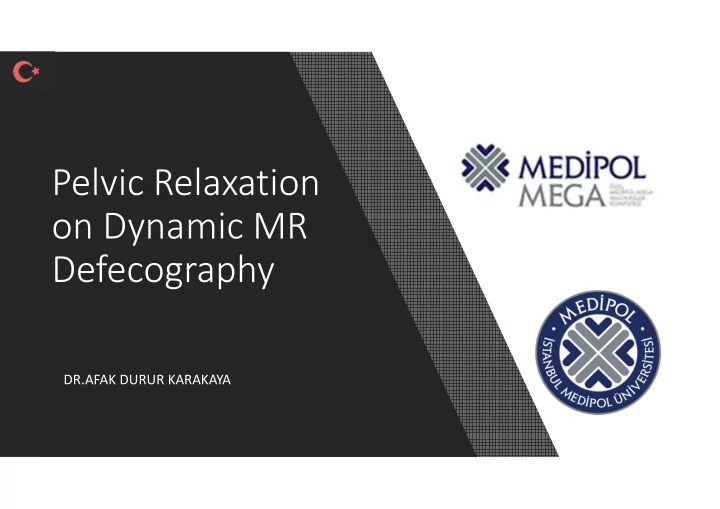

Pelvic Relaxation on Dynamic MR Defecography DR.AFAK DURUR KARAKAYA
Introduction Dynamic magnetic resonance defecography (DMRD) can provide anatomical and functional information of the pelvic region and defecation.
Objective/Purpose To describe the grading system of DMRD and to demonstrate some special findings of pelvic relaxation.
MR technique • 240-mL of sonography gel was instilled into the rectum by means of a small rectal catheter with the patient in the right decubitus position. • Axial, coronal and sagittal T2-weighted sequence • Four dynamic phases were acquired. • These phases are : • Rest, • Maximal sphincter contraction • Maximal strain, • Defecation • There was a rest period of 2 seconds between these phases.
Rest
Rest
Maximal sphincter contraction
Maximal sphincter contraction
Maximal strain
Maximal strain
Defecation
Defecation
Results 63 patients assessed • The affected compartments were posterior 62, middle 35 and anterior 36 • In addition • � Spastic pelvic floor syndrome (19) � Rectocele (55) � İntussuception (28) � Enterocele (3) � Hypermobility of uretra (1) Minimal Moderate Severe Anterior 16 16 2 Middle 3 13 19 Posterior 3 20 39
Image analyses Image analyses Image analyses Image analyses • Pelvic floor is divided into three compartments: • The anterior compartment • (the lower urinary tract) • The middle compartment A (the vagina/uterus), • • And the posterior compartment M P (the ano rectum). •
Image Image Image Image analyses analyses analyses analyses • The pubococcygeal line is drawn from the inferior border of the pubic symphysis to the last coccygeal articulation. • We have measured in centimeters � The urine bladder base (anterior compartment) � The cervico vaginal junction or the vaginal cuff (middle compartment) � The anorectal junction (posterior compartment).
Image Image analyses analyses Image Image analyses analyses • Grading of pelvic floor descent is described. Anterior/Middle/ Posterior Mild 2-4 Modarate 4-6 Severe > 6 cm
Pathologies
Pathologies
Pathologies � During defecation there is severe descent of the anorectal junction which is located below the pubococcygeal line. � In addition, enterocele and anterior rectocele.
Pelvic floor relaxation can be described by abnormal hiatal enlargement and pelvic floor descent during maximal strain. Pelvic floor relaxation occurs as the fascial Pelvic and muscular supports of the pelvic floor when it is weakened over time. Relaxation As the pelvic floor relaxation increases, the pelvic organs supported are also more likely to descend, indicating weakening of their supportive fascia and ligaments.
• DMRD is a very effective and reliable method in the diagnosis and treatment efficiency of the functional pelvic floor diseases because it Conclusion provides both anatomical and functional information and it does not include any ionizing radiation.
References Foti PV, Farina R, Riva G ve ark. Thapar RB, Patankar RV, Kamat Pomian A, Lisik W, Kosieradzki M, Pelvic floor imaging: comparison RD, Thapar RR, Chemburkar V. Barcz E. Obesity and Pelvic Floor between magnetic resonance MR defecography for obstructed Disorders:A Review of the imaging and conventional defecation syndrome. Indian J Literature. Med Sci Monit. defecography in studying outlet Radiol Imaging. 2015 Jan- obstruction syndrome. Radiol 2016:3; 22:1880-6. Mar;25(1):25-30. Med. 2013; 118:23-39
Recommend
More recommend